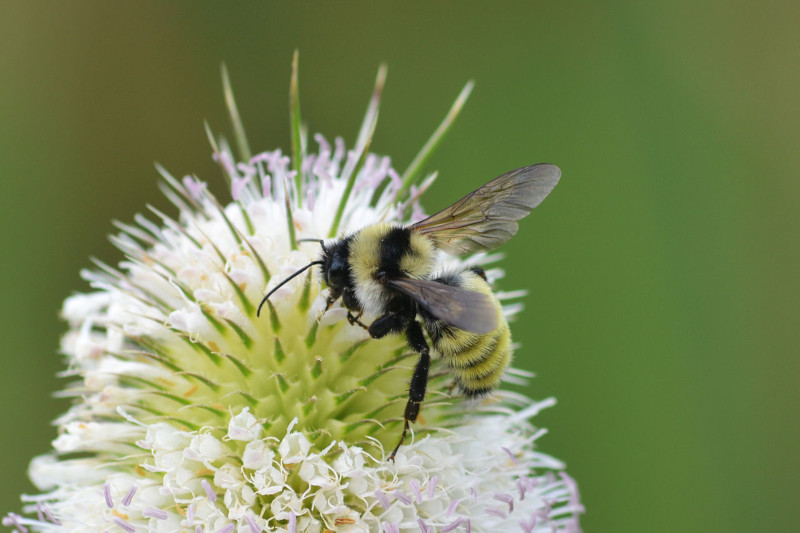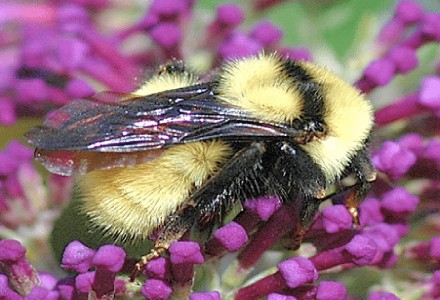
Golden Northern Bumblebee Facts
- The descriptive term Golden Northern Bumblebee serves as the common name for a particularly beautiful variety of bumblebee. This highly fascinating small invertebrate also bears the distinctive scientific name of the Bombus fervidus.
- By either name, though, the creature remains an impressive species. Fascinatingly, within its native range, it remains an important pollinator. The natural wonder also represents on of the very first in its zone of habitation to be scientifically identified.
- This occurred through the efforts of the well-known Danish zoologist Johan Christian Fabricius, in 1798. The marvelous insect also displays some quite fascinating behavioral patterns. This even includes a communication system based on dancing.
- This incredible product of evolution also developed a highly specialized nest defense strategies for different categories of intruders. When intrusions into the nest occur, it covers the intruder with honey to hamper its movement.
- Like many species of bees, the population of the Golden Northern Honeybee appears to be declining rapidly. The IUCN currently lists it as Vulnerable, as a result. This listing appears on the organization’s Red List of Threatened Species.
- This highly lamentable decline appears to be occurring due to a variety of factors. While these include habitat loss, it’s also threatened by the ongoing and escalating effects of climate change, much like many other species around the world.
Related Articles
Cuckoo Bee Shrill Carder Bee Perdita minima
Golden Northern Bumblebee Physical Description
The wonder of the Golden Northern Bumblebee does not extend to size. In fact, it constitutes a small variety of bumblebee. Sexual dimorphism plays a factor as well. Female workers reach 0.75 in (1.9 cm) in length, while male drones only average 0.5 in (1.3 cm).
This small but truly beautiful example of its kind also displays the sex-based characteristic in another way. The wingspan also appears to be gender-related in this particular arthropod. That particular manifestation of the principle sets it apart from others.
Firstly, a female’s wings most commonly measure approximately 1.6 in (40 mm) in overall span. Secondly, however, that of the males only averages a measurement of 0.86 in (22 cm). This represents a quite significant difference for a species of its size.
It’s also well known for its dazzling appearance, which never fails to please the eye. Its coloring appears as a combination of black and golden yellow. In yet another gender-based difference, though, the male typically displays more yellow than the female.
In other respects, individuals of both genders appear remarkably similar. The body of both grows covered with numerous short, but thick, hairs. The amazing Golden Northern Bumblebee also distinguishes itself from the smaller honeybee in an important way.
You see, unlike the tinier honeybee, this remarkable species does not die after inflicting a sting. In point of fact, the impressive invertebrate remains capable of repeatedly attacking an opponent with its stinger. This rarely forms a danger to humans, however.
- Kingdom: Animalia
- Phylum: Arthropoda
- Class: Insecta
- Order: Hymenopterta
- Family: Apidae
- Genus: Bombus
- Species: B. fervidus
Golden Northern Bumblebee Distribution, Habitat, and Ecology
The serenely beautiful Golden Northern Bumblebee developed as endemic to only a specific section of the globe, like many bees. More specifically, however, that region consists of somewhat limited and restricted portions of the continent of North America.
To be even more precise, its populations primarily concentrate in scattered portions of that continent. The fascinating arthropod most commonly appears in the northeast portion of the United States, where it distinguishes itself from competing species.
The marvelous arthropod does exhibit very restrictive habitat preferences, regrettably. This insect generally prefers to construct its nest in either tall grasslands or temperate savannas. Yet it also often adapts to inhabit farms and even cities with sufficient greenery.
The nests of this particular bee occur either underground or above, and commonly consist of a loose mass of grass held together with avian feces. Further, adult specimens of the Golden Northern Bumblebee feed entirely on the nectar of flowering plants.
In contrast, the young of the species are fed pollen collected by the workers. Nest populations also generally remain quite small. Amazingly, that number rarely exceeds sixty adults and pupae. Lifespans range from 34 days for workers to 12 months for the queen.
Species Sharing Its Range
Check out our other articles on Fabulous Herbaceous Plants Named After Animals, Pesquet’s Parrot, Havasu Falls, Long-Finned Pilot Whale, Tasmanian Giant Freshwater Crayfish

